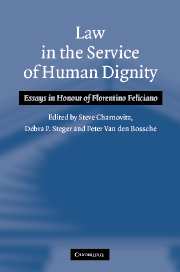Book contents
- Frontmatter
- Contents
- List of contributors
- Preface
- Biographical note
- List of abbreviations
- PART I Reflections on the contributions of Florentino Feliciano to international law
- PART II Insights into the World Trade Organization
- PART III The changing landscape of investment arbitration
- PART IV New challenges in international adjudication
- 21 From Preston to Prescott: globalizing legitimate expectation
- 22 The independence of the international judiciary: some introductory thoughts
- 23 ‘Straddling and highly migratory flags’ before the International Tribunal for the Law of the Sea
- 24 Collective security and the personalization of peace
- 25 Some thoughts on ‘Asian’ approaches to international dispute resolution
- 26 The Cameroon v. Nigeria; Equatorial Guinea Intervening (Land and Maritime Boundary) Judgment
- Bibliography of works by Florentino Feliciano
- Index
25 - Some thoughts on ‘Asian’ approaches to international dispute resolution
from PART IV - New challenges in international adjudication
Published online by Cambridge University Press: 29 July 2009
- Frontmatter
- Contents
- List of contributors
- Preface
- Biographical note
- List of abbreviations
- PART I Reflections on the contributions of Florentino Feliciano to international law
- PART II Insights into the World Trade Organization
- PART III The changing landscape of investment arbitration
- PART IV New challenges in international adjudication
- 21 From Preston to Prescott: globalizing legitimate expectation
- 22 The independence of the international judiciary: some introductory thoughts
- 23 ‘Straddling and highly migratory flags’ before the International Tribunal for the Law of the Sea
- 24 Collective security and the personalization of peace
- 25 Some thoughts on ‘Asian’ approaches to international dispute resolution
- 26 The Cameroon v. Nigeria; Equatorial Guinea Intervening (Land and Maritime Boundary) Judgment
- Bibliography of works by Florentino Feliciano
- Index
Summary
Toy Feliciano and I met for the first time nearly forty years ago, when he came to Washington as legal counsel to a Philippine delegation negotiating with the World Bank. A brilliant academic and professional career saw him rise to the highest level of his country's judiciary, and eventually grace the international judicial system in the field of trade law. He moves with ease between the often separate worlds of domestic and public international law, bringing to bear in each of them the same rigorous standards of legal scholarship and integrity, uniquely benefiting both.
Introduction
A recent work on dispute resolution in Asia opens with the question: ‘Is there an “Asian” style of dispute resolution?’, recalling in this context references to ‘Asian values’ and to ‘the Asian way’ of doing business. After a careful review of their material, the authors incline to a response in the negative:
It is very difficult to identify any common cultural and legal norms or sources or positive law that are shared from the former Soviet Far East to Sulawesi. We cannot point to unifying systemic characteristics of law in Asia today because there is no organic relationship linking the cultural and legal histories of all the countries loosely identified as ‘Asia’.
They later conclude:
Local legal, commercial and political culture and economic endowments cannot be reduced to core components that will remain static and polarized. Understanding the profile of individual Asian legal systems at a given point in time is essential, but essentializing a region-wide ‘Asian’ approach to dispute resolution and law when ‘Asia’ itself is an artificial construct is probably a futile exercise.
- Type
- Chapter
- Information
- Law in the Service of Human DignityEssays in Honour of Florentino Feliciano, pp. 350 - 377Publisher: Cambridge University PressPrint publication year: 2005



